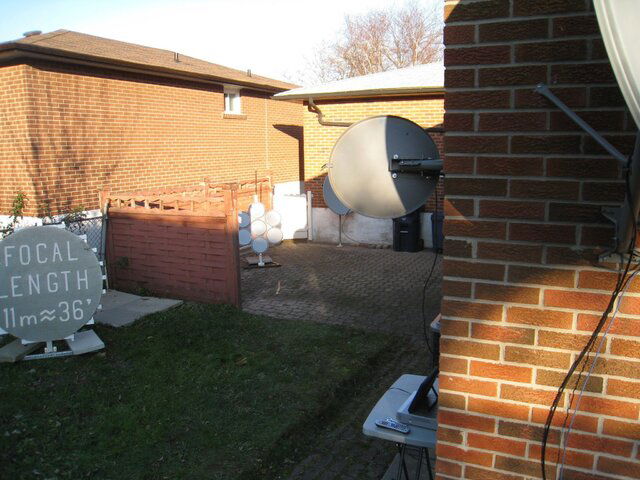Receiving FTA signal after double reflection
- Thread starter polgyver
- Start date
- Latest activity Latest activity:
- Replies 25
- Views 4K
You are using an out of date browser. It may not display this or other websites correctly.
You should upgrade or use an alternative browser.
You should upgrade or use an alternative browser.
- Status
- Please reply by conversation.
Recently I completed some trials in receiving satellite signal after bouncing it off additional surface which has rather long focal length. I built sort of dish, 46" diameter, which is very shallow, less than half inch. I was hoping to put LNB in its focus and catch a signal. Unfortunately, the focus was not well defined (I think some inevitable inaccuracies happened when I made this dish, also the surface of sheet metal was not straight). So I had to use additional small concave surface, for which I used frying pan lid, and later spherical cooking utensils. Finally I was able to receive signals from 97W and 101W simultaneously, using 2 receivers and 2 small TV's. These cooking pans are 10" and 12" and for receiving these satellites they were spaced 28" apart, with one 12" higher than the other. I had to reverse skew, too. (Just wonder how it would be with circular polarization...). Maybe this technique will be useful for people not having direct access to the sky from their home? The "reflector" could be located somewhere in the backyard, and one or more small dishes just below the fascia, or (?) who knows, maybe behind window? I tried to add some photos, but older photos from my previous post popped up, now I see I have to learn more how to use attachments. Luckily I was able to add my avatar. If anybody is interested, please, PM me and I will e-mail photos. Cheers, polgyver
Pots and pans for satellite?? Woa! You are a true mad scientist!
If the bowl has right geometry, it will work. It can not be too deep, though. Most likely, it is spherical. The focus of spherical bowl is at half the radii of such bowl. I considered using spherical glass sheds from electric fixture (covered by aluminum duct tape) as those secondary dishes. But when I put two plastic rulers on these glass spheres, (on their ends) and found, that the radii is about 13" , I realized that the focus is only 6.5" from the surface, and it is too close. The LNB has certain angle of "sight", about 80 degree. It is like "normal" lenses of a camera. With the glass "dish" the LNB would have to be like wide angle lens, and it is not. So I chose the steel spherical pans. The LNB is an obstruction to the waves, but it still worked. Had I tried to use the pan as an offset reflector, I would have to deal with the "coma" problem. Of course, paraboloidal surface would be the best.I've pondered before what would happen if I rigged up one of those big metal mixing bowls
Finally, I completed this project with 7 pizza plates. However, probably due to the gaps between plates, the strength is only 40, and quality is 80. Overall the reflecting surface of primary cluster is much smaller than the surface of one-piece "dish" used earlier. The secondary 18" dish had to be mounted horizontally, as it had to be directed downward. The small channel attached to the 18" dish helped me to aim it at the cluster.Thanks for words of appreciation. The idea of making a reflecting surface having very remote focus came to me when I was watching on History Channel a program about architectural "disasters", one was about a building covered with metal sheets which reflected Sun rays into other peoples' houses or apartments. The flat dish I made has a serious flaw : its focal length can not be changed. Now I plan to make reflective surface consisting of 7 round metal plates where the 6 around the central one could be "tuned" or regulated by bolts. With such a concentrator, the focal length could be changed. Instead of "focus" there would be an area with 7-fold intensity of signal wave. Perhaps it would suffice to receive reliable FTA signal on secondary small (18" or smaller) dish. Of course the frame holding these 7 plates should be very stable, especially if focal length would be about 50' or - maybe? - even to 100' (30 m). I also knew about KECK telescope in Hawaii, consisting of 36 mirrors, each sized 1 m, connected with precise hydraulics driven by fast computers - this thing is truly amazing!




- Status
- Please reply by conversation.
Similar threads
- Replies
- 6
- Views
- 271
- Replies
- 109
- Views
- 4K
- Replies
- 21
- Views
- 1K
- Replies
- 0
- Views
- 466
- Replies
- 37
- Views
- 3K

